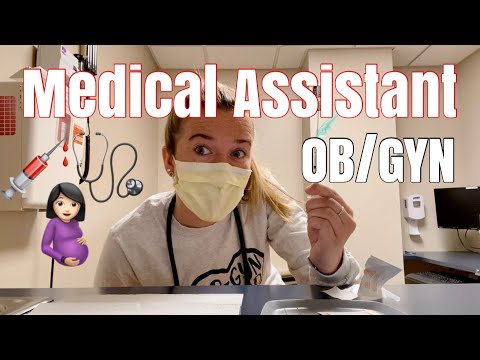Women’s Health Care: What Medical Assistants Need to Know
Contents
- Women’s Health Care: An Overview
- The Role of Medical Assistants in Women’s Health Care
- Common Women’s Health Care Services
- Women’s Health Care during Pregnancy
- Postpartum Care for Women
- Menopause and Women’s Health Care
- Common Health Concerns for Women
- Promoting Women’s Health
- Resources for Women’s Health Care
- Further Reading on Women’s Health Care
As Medical assistants it’s important to be up-to-date on the latest information regarding women’s health care By staying informed, we can provide the best possible care to our patients. Here’s a rundown of what Medical Assistants need to know about women’s health care.
Checkout this video:
Women’s Health Care: An Overview
Women’s health care needs are unique and complex, and require special expertise and knowledge. Medical assistants who work in women’s health care settings need to be aware of the unique physical, psychological, and social needs of women. They also need to be familiar with the special tests and procedures that are used to diagnose and treat conditions that are specific to women.
Women’s health care needs vary throughout their life span, so medical assistants need to be prepared to provide care for women of all ages. They also need to be aware of the different health risks that women face at different stages of their lives. For example, medical assistants who work in obstetrician/gynecologist offices need to be familiar with the special needs of pregnant women, while those who work in menopause clinics need to be familiar with the needs of menopausal women.
Medical assistants who are knowledgeable about women’s health care can play a vital role in providing high-quality care for their patients. They can also help to educate patients about how to maintain good health and prevent disease.
The Role of Medical Assistants in Women’s Health Care
Medical assistants play an important role in women’s health care. They are often the first point of contact for patients, and they play a vital role in educating patients about their health. Medical assistants can also help to identify early signs and symptoms of diseases and conditions that affect women, which can allow for early diagnosis and treatment. In addition, medical assistants can provide support to women who are pregnant or planning to become pregnant. They can help to schedule appointments, answer questions about prenatal care, and provide education about the different stages of pregnancy.
Common Women’s Health Care Services
As a medical assistant you may be called upon to provide service to female patients for a variety of reasons related to reproductive health. It is important to be familiar with the various types of procedures and treatments associated with women’s health care, as well as the slang or vernacular terms that might be used by patients. The following is a list of common women’s health care services:
– Annual pelvic exam: A yearly gynecologic exam that includes a Pap smear, breast exam, and sometimes STD testing.
– Birth control: Also called contraception, birth control refers to any method used to prevent pregnancy. This can include hormonal methods (like the pill), intrauterine devices (IUDs), barrier methods (like condoms), or surgical sterilization (tubal ligation).
– Breast examination: An examination of the breasts performed by a healthcare provider to check for lumps, pain, or other changes.
– Colposcopy: A diagnostic procedure during which a magnifying instrument is used to examine the cervix for signs of disease.
-Endometriosis: A condition in which tissue that grows inside the uterus is found outside of the uterus, often causing pain and irregular bleeding.
– Family planning: The deliberate prevention of pregnancy through the use of birth control methods.
-Fertility: The natural ability to conceive and carry a pregnancy to term.
-Gynecology: The branch of medicine that deals with the health of the female reproductive system.
-Mammogram: An X-ray image of the breast used to detect abnormalities such as tumors.
– Menopause: The natural cessation of menstruation that occurs when a woman reaches middle age.
– Obstetrics: The branch of medicine that deals with pregnancy and childbirth.
-Ovulation: The release of an egg from one of the ovaries each month. This is typically when a woman is most fertile and can become pregnant if she has unprotected intercourse.
-Pap smear: A screening test for cervical cancer in which cells are collected from the cervix and examined under a microscope.
-Pregnancy: The condition of carrying a developing embryo or fetus inside the uterus; typically lasts 40 weeks from conception to delivery.
Women’s Health Care during Pregnancy
Medical assistants who work in obstetrics and gynecology need to have a good understanding of the changes a woman’s body goes through during pregnancy, as well as the various tests and treatments associated with pregnancy. Here is a basic overview of what medical assistants need to know about women’s health care during pregnancy.
During pregnancy, a woman’s body undergoes many changes in order to accommodate the growing fetus. These changes can affect every system in the body, from the circulatory system to the digestive system. Some of the more common changes that medical assistants should be aware of include:
-An increase in blood volume and circulation
-A change in the shape and size of the uterus
-An increase in hormone production
-A decrease in the level of stomach acid production
In addition to these physical changes, pregnant women also experience a number of emotional and psychological changes. These can include mood swings, anxiety, and depression. It is important for medical assistants to be able to recognize these changes so that they can provide appropriate support and referrals if necessary.
Throughout pregnancy, women will have various tests and examinations to monitor their health and the health of their fetus. Some of these tests may be performed by medical assistants, while others will be performed by doctors or other healthcare professionals. Common tests and procedures that medical assistants should be familiar with include:
-Prenatal blood testing
-Prenatal ultrasound
-Amniocentesis
-Fetal monitoring
Postpartum Care for Women
After a woman gives birth, her body needs time to recover and heal. This is called the postpartum period. During this time, it’s important for medical assistants to be aware of the different physical and emotional changes that a woman may experience.
The first few weeks postpartum are often the most challenging. A woman’s hormone levels are changing rapidly, which can lead to mood swings and feelings of depression or anxiety. It’s also common for new mothers to experience difficulty sleeping and eating, as well as pain in the perineal area (the area between the vagina and anus).
Physical changes that medical assistants should be aware of include:
-An increase in vaginal discharge, which may be yellow or green in color
-Swelling in the vulva and vagina
-Heavier or lighter bleeding than a period
-Cramping
-Constipation or diarrhea
-Breast tenderness or engorgement
-C-section incision healing
Menopause and Women’s Health Care
As women age, they go through several changes in their bodies. One of the most significant changes is menopause, which usually occurs around age 50. This guide will briefly explore what medical assistants need to know about menopause and women’s health care.
Before menopause, a woman’s ovaries produce most of her estrogen. Estrogen is a hormone that helps regulate the menstrual cycle, among other things. During menopause, the ovaries stop making estrogen, and levels of the hormone drop sharply. This can cause a variety of symptoms, including hot flashes, vaginal dryness, and sleep problems.
There are several treatments available to help ease menopausal symptoms. Hormone therapy is the most effective treatment, but it does have some risks associated with it. Other treatments include lifestyle changes (such as avoiding triggers for hot flashes), over-the-counter medications, and natural remedies.
Menopause can also affect a woman’s health in other ways. Because estrogen helps protect bones from deterioration, bone loss is a common concern during and after menopause. Women are also at increased risk for heart disease and other conditions during this time. Medical assistants can help support women going through menopause by providing information about these risks and helping them stay on top of their health care needs.
Common Health Concerns for Women
There are many health concerns that women face that men do not, such as hormones, pregnancy, and menopause. It is important for medical assistants to be aware of these common health concerns so that they can provide the best possible care for their patients.
Hormones: Women’s bodies are constantly changing due to hormones. These changes can cause a variety of symptoms, such as mood swings, weight gain, and fatigue. Hormonal changes can also affect a woman’s risk for certain diseases, such as breast cancer.
Pregnancy: Pregnancy is a time of great change for a woman’s body. Medical assistants need to be aware of the different stages of pregnancy and the changes that occur during each stage. They also need to know how to care for pregnant women and what signs to look for if there are complications.
Menopause: Menopause is the time in a woman’s life when her ovaries stop producing eggs and her menstrual cycles come to an end. This transition can cause a variety of symptoms, such as hot flashes, night sweats, and vaginal dryness. Medical assistants should be familiar with these symptoms so that they can provide care and support to women who are going through menopause.
Promoting Women’s Health
As a medical assistant you play an important role in promoting women’s health. You can provide women with the information they need to make good decisions about their health, and you can help them get the care they need to stay healthy.
Medical assistants can do many things to promote women’s health. Here are some tips:
-Educate yourself about women’s health issues. Read books and articles, and attend workshops and conferences on women’s health topics.
-Be a resource for patients. When patients have questions about their health, direct them to reliable sources of information, such as reputable websites or books.
-Encourage patients to see their healthcare provider regularly. Help them make appointments and find transportation if needed.
-Make sure that patients get the screenings and vaccinations recommended for their age and health status.
-Help patients manage their chronic conditions, such as diabetes or high blood pressure.
-Encourage patients to lead a healthy lifestyle by eating healthy foods, exercising regularly, and avoiding tobacco and excessive alcohol use.
Resources for Women’s Health Care
As a medical assistant you will likely encounter patients who are seeking information on women’s health care. There are numerous resources available to help you provide accurate and up-to-date information to your patients.
The U.S. Department of Health and Human Services’ Office on Women’s Health provides a variety of resources on women’s health topics, including many in Spanish. You can access these resources online at https://www.womenshealth.gov/.
The American College of Obstetricians and Gynecologists (ACOG) is another excellent resource for information on women’s health care. ACOG’s website (https://www.acog.org/) offers a wealth of information on everything from contraception to pregnancy and menopause.
These are just a few of the many resources available to you as a medical assistant working with patients who are seeking information on women’s health care topics. By familiarizing yourself with these resources, you can be sure that you are providing your patients with accurate, up-to-date information.
Further Reading on Women’s Health Care
There is a wealth of information available on women’s health care. Here are some additional resources that medical assistants may find useful:
-The American College of Obstetricians and Gynecologists: https://www.acog.org/
-The Office on Women’s Health: https://www.womenshealth.gov/
-The Centers for Disease Control and Prevention: https://www.cdc.gov/womenshealth/







